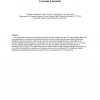Free Online Productivity Tools
i2Speak
i2Symbol
i2OCR
iTex2Img
iWeb2Print
iWeb2Shot
i2Type
iPdf2Split
iPdf2Merge
i2Bopomofo
i2Arabic
i2Style
i2Image
i2PDF
iLatex2Rtf
Sci2ools
WPES
2004
ACM
2004
ACM
Specifying privacy policies with P3P and EPAL: lessons learned
As computing becomes more ubiquitous and Internet use continues to rise, it is increasingly important for organizations to construct accurate and effective privacy policies that document their information handling and usage practices. Most privacy policies are derived and specified in a somewhat ad-hoc manner, leading to policies that are of limited use to the consumers they are intended to serve. To make privacy policies more readable and enforceable, two privacy policy specification languages have emerged, P3P and EPAL. This paper discusses the effectiveness of these languages within the context of a case study that entailed the expression of common online privacy statements for a healthcare website, employing requirements engineering quality factors as a framework for our discussion.
| Added | 30 Jun 2010 |
| Updated | 30 Jun 2010 |
| Type | Conference |
| Year | 2004 |
| Where | WPES |
| Authors | William H. Stufflebeam, Annie I. Antón, Qingfeng He, Neha Jain |
Comments (0)

